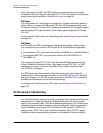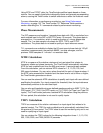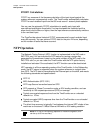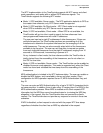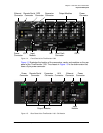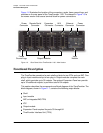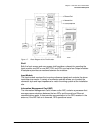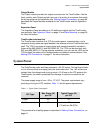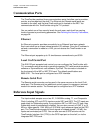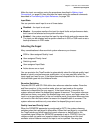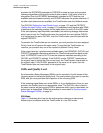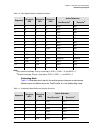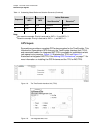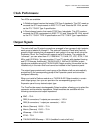
Chapter 1 Overview of the TimeProvider
Functional Description
32 TimeProvider User’s Guide 097-58001-02 Revision G – April 2008
Integrated Information Management Card with TimeProvider Interface Unit
(IMC/TPIU)
For users who use the GPS feature, the integrated IMC/TPIU combines the features
of the IMC card with the TPIU into the same size footprint as a stand-alone IMC
card (see the descriptions of the IMC and TPIU). The IMC/TPIU reduces rack space
requirements by eliminating the rack mounted stand-alone TPIU. Functionally, the
IMC/TPIU supports the same functions as the IMC card, controlling all
communication channels within the TimeProvider and managing GPS control
processes. If the IMC/TPIU fails or is removed, GPS operations cease.
Input/Output and Clock Module (IOC)
The TimeProvider operates with one or two IOCs. A second IOC in the shelf
provides protection should the primary IOC fail. The IOC accepts the incoming
reference signal and decodes the SSM, if present.
With the system properly provisioned and a reference signal selected, the local
oscillator in the IOC operates in one of the following states:
Warm-up – For up to 20 minutes after applying power to the shelf, the IOC
operates in warm-up mode.
Fast-lock – After warm-up is complete, the IOC enters the fast-lock state, where it
quickly frequency-locks the local oscillator to the reference input.
Normal lock – After the IOC has completed the fast-lock cycle, it enters the
normal lock mode, in which the TimeProvider uses the proper amount of filtering
for the selected mode. When set to the SSU mode and locked to an active input
traceable to a Primary Reference Source (PRS), the TimeProvider complies with
the G.811 and GR-2830-CORE standards.
Holdover – If the reference signal is lost, then the clock enters the holdover
mode. The accuracy of the TimeProvider output is then dependent on the quality
level of the oscillator in the IOC.
Free-run – If the IOC starts without a system reference, the TimeProvider enters
the free-run state after warm-up. If a reference is applied, then the TimeProvider
enters the fast-lock and then the normal-lock states.
Bridging – In the event that all input references are lost, the TimeProvider goes
into the bridging mode where the outputs continue to provide accurate timing
outputs for a user-defined amount of time. If the inputs have not been requalified
before the bridging time has elapsed, then the TimeProvider enters the holdover
mode.
After the IOC has been in the Normal lock mode for at least three days, SmartClock
holdover mode becomes available. Compared to the normal holdover mode, this
mode provides a superior output quality.



